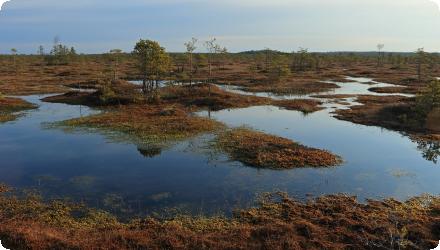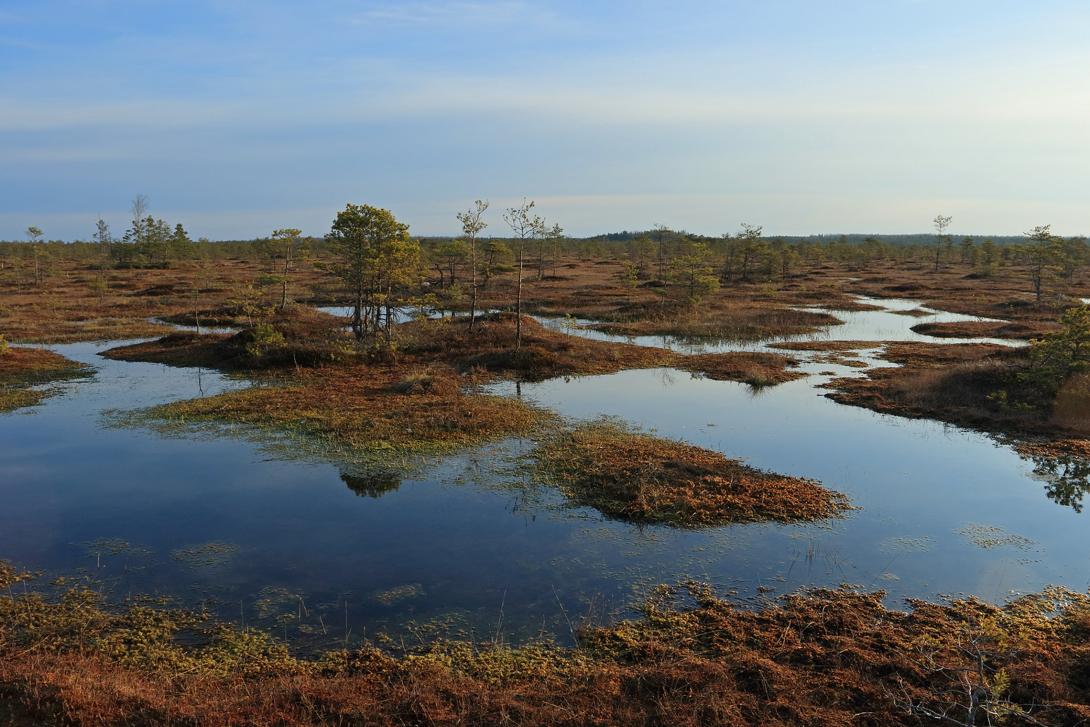Last update
2025
Summary
Kamanos Strict Nature Reserve is the largest raised bog (2,434 ha) in the northern Lithuania region (a farming region) with ridge–pool complexes, numerous small lakes (over 120 pools each less than 2 ha in area) and surrounding wet forests. In 65 ha of selected bogs and meadows restored with 18.5 km of ditches dammed Kamanos Strict Nature Reserve. The measures were implemented in the frame of a larger UNDP-GEF project in 2004–2010. Further hydrological restoration was carried out under the LIFE WETLIFE2 project (2014–2018), blocking 37 km of drainage ditches and improving water conditions over 670 ha. These actions supported bog habitats and species like the Aquatic Warbler. The site is now part of the eLTER network, with ongoing ecological monitoring and climate data collection.
Position
Latitude
56.280151
Longitude
22.662279
Project
NWRM
National Id
Lithuania_03
Installation date
2010
Implementation Status
RBD code
LT2300
Transboundary
0
Photo gallery
Location of the project
The Kamanos Strict Nature Reserve lies in the Akmenė District of Šiauliai County, northwestern Lithuania (approx. 56°16.3′ N, 22°47.3′ E), situated just a few kilometres west of Ašvėnai village. While surrounded by cultivated lands and forest, it is accessible only via local roads leading to the visitor centre in Akmenė II.
NUTS Code
LT00 - Latvija
Project's objectives
Objective 1: Demonstrate improved in-situ wetland management at five globally significant wetland sites in Lithuania including Kamanos, addressing degradation threats such as drainage, overgrowth of meadows, and unsustainable land use.
Objective 2: Institutionalize best practices through a multisectoral mechanism (the "Multisectoral Wetlands Working Group") to replicate lessons learned across other wetland sites in Lithuania and integrate conservation principles into relevant sectoral policies (e.g., agriculture, forestry, tourism) for sustainable wetland management.
Objective 2: Institutionalize best practices through a multisectoral mechanism (the "Multisectoral Wetlands Working Group") to replicate lessons learned across other wetland sites in Lithuania and integrate conservation principles into relevant sectoral policies (e.g., agriculture, forestry, tourism) for sustainable wetland management.
Involved Partners
| Authority type | Authority name | Role | Comments |
|---|---|---|---|
Climate zone
warm temperate moist
Temperature
6.74
Precipitation
585
Annual rainfall range
300 - 600 mm
Elevation range
111
Groundwater level
In central (pristine) bog : 4.5 cm to 30 cm below the surface. In actively drained zones, fluctuations ranged from 8 cm to 51 cm.
Vegetation class
Sphagnum mosses
Water bodies: Ecological Status
Poor
Water bodies: Chemical Status
Failing to achieve good
Water quality status
This is water bosies status around the reserve, there is no info about the Kamanos reserve's waterbodies themselves.
Project scale
Micro
Project scale specification
The restoration and conservation actions in the Kamanos Strict Nature Reserve focus on a clearly defined protected area (2,434 ha), involving localised hydrological interventions such as ditch blocking, habitat restoration, and biodiversity monitoring. All measures are site-specific and confined to the boundaries of the reserve, making this a typical micro-scale project.
Performance timescale
Immediate
Project area
1283
Area subject to Land use change or Management/Practice change (ha)
1218
Size
18.5
Size unit
km
Lifespan
10
Costs total information
€1,520,701 for LIFE WETLIFE 2 (LIFE13 NAT/LT/000084) (2014-2018) Restoration of 670 ha of bog habitats; 37 km of ditches blocked; 300 dams built; monitoring and public awareness activities.
US $13,865,400 for UNDP-GEF (2004-2010) “Conservation of Inland Wetland Biodiversity in Lithuania”, Restoration of 65 ha of bogs and meadows; 18.5 km of drainage ditches blocked; development of reserve management plans.
US $13,865,400 for UNDP-GEF (2004-2010) “Conservation of Inland Wetland Biodiversity in Lithuania”, Restoration of 65 ha of bogs and meadows; 18.5 km of drainage ditches blocked; development of reserve management plans.
Compensations
0
Policy context
Extensive drainage of the bog for agriculture and forestry, loss of biodiversity, change f habitat
Land ownership
The core area of the Kamanos Strict Nature Reserve is entirely state-owned, while its buffer zone includes both state-owned and privately owned parcels.
Community involvment
Yes
Design consultation activity
| Activity stage | Name | Key issues | Comments |
|---|---|---|---|
|
Design phase
|
WETLIFE 2 project seminars
|
14 seminars and volunteer-based actions aimed at:
Raising awareness of the importance of peatland ecosystems and the problems caused by drainage. Engaging local stakeholders directly in conservation activities. |
Policy target
| Target purpose |
|---|
|
Runoff control
|
|
Increase Water Storage
|
|
Improved Biodiversity
|
|
Oher Societal Benefits
|
Policy pressure
| Pressure directive | Relevant pressure |
|---|
Policy impact
| Impact directive | Relevant impact |
|---|
Requirement directive
| Requirement directive | Specification |
|---|
Contractual arrangements
0
| Arrangement type | Responsibility | Role | Name | Comments |
|---|
Part of wider plan
1
Wider plan type
| Wider plan type | Wider plan focus | Name | Comments |
|---|---|---|---|
|
Conservation of Inland Wetland Biodiversity in Lithuania’
|
National project
|
Groundwater/hydrological levels (post-restoration). As part of the WETLIFE 2 project, the reserve organized 14 seminars and volunteer-based maintenance or monitoring actions, contributing to active stakeholder engagement and localized stewardship.
Maintenance
Maintenance is carried out by the Kamanos Reserve Directorate and includes regular inspection of water level control structures (e.g., dams) and ongoing hydrological monitoring to ensure restoration effectiveness.
Catchment outlet
Change of water table level in the bog
For all Lithuania's peatlands combined : Rewetting peatlands → ~€170M annual savings; drainage → ~€309M annual losses (6.6% of GDP)
Information on Increased groundwater level
Groundwater level rise: After damming drainage ditches (1–1.2 m deep), the groundwater table increased by 9.8 to 12.2 cm, with the effect detectable up to 980 m from the ditch. In extensively drained areas, water levels matched undrained (control) plots within 4 years; in more intensively drained zones, recovery to control levels is projected within 12 years
Information on Restoring hydraulic connections
Restored hydrological conditions (WETLIFE 2 project): 37 km of ditches were blocked, leading to restoration of 40 ha of bog lag zones, benefiting 670 ha of mire habitat
Water quality overall improvements
N/A info
Soil quality overall soil improvements
N/A info
1
The sphagnum community is beginning to recover in places where it had been negatively impacted before. Mire habitats supporting species such as Eurasian golden plover (Pluvialis apricaria), wood sandpiper (Tringa glareola), black grouse (Tetrao tetrix), and woodpeckers (Dendrocopos leucotos, D. medius) are expected to benefit.
Information on Ecosystem impact climate regulation
Improved storage of GHG in peatland.
Information on Ecosystem provisioning services
increase in wild cranberries yields
Key lessons
• Mid-Term Evaluations should have stringent timing requirements.
All GEF projects should mandate that mid-term evaluations occur at a specific date in the project cycle. This should include recruitment of international expertise at least six months prior to the planned MTE date.
• Relatively small management teams can produce big results.
Successful implementation project with a relatively small full-time technical and management staff is an indication of the project benefiting from a contemporary, strategic approach; authentic stakeholders buy-in; an implementation environment with relatively good capacity; and capable, motivated leadership. The team also showed a willingness to identify and recruit necessary technical assistance.
• Valuable indicators measure impact and quality, not just production.
Projects should benefit from carefully designed indicators that provide an accurate measurement of the delivery of outputs but, more importantly, measure the impact delivery has on objective conservation values.
• Projects may benefit from continuity between PDF-B and implementation teams.
This project benefited from having the same strong team working from the beginning of the project through to implementation. Capacity, team building, partnerships, and project “historical perspective” were all enhanced with this consistency.
All GEF projects should mandate that mid-term evaluations occur at a specific date in the project cycle. This should include recruitment of international expertise at least six months prior to the planned MTE date.
• Relatively small management teams can produce big results.
Successful implementation project with a relatively small full-time technical and management staff is an indication of the project benefiting from a contemporary, strategic approach; authentic stakeholders buy-in; an implementation environment with relatively good capacity; and capable, motivated leadership. The team also showed a willingness to identify and recruit necessary technical assistance.
• Valuable indicators measure impact and quality, not just production.
Projects should benefit from carefully designed indicators that provide an accurate measurement of the delivery of outputs but, more importantly, measure the impact delivery has on objective conservation values.
• Projects may benefit from continuity between PDF-B and implementation teams.
This project benefited from having the same strong team working from the beginning of the project through to implementation. Capacity, team building, partnerships, and project “historical perspective” were all enhanced with this consistency.
Success factor(s)
| Success factor type | Success factor role | Comments | Order |
|---|---|---|---|
|
Attitude of decision makers
|
main factor
|
1
|
|
|
Financing possibilities
|
main factor
|
<p>EU funding was a big help.</p>
|
2
|
|
Available support tools
|
main factor
|
<p>During the MOMENT project, it was possible to gain knowledge about the similar retention ponds in Sweden. As this was one of the first (pilot) retention ponds in Lithuania, therefore, knowhow was very usefull.</p>
|
3
|
|
Legal obligations
|
main factor
|
4
|
Driver
| Driver type | Driver role | Comments | Order |
|---|---|---|---|
|
Other
|
The goal should have been reached in the most cost effective measure. Small dams made of plastic were the best option. Construction costs were minimised, since no outsourcing was needed and SNR staff was able to build it.
|
1
|
Transferability
The measure is highly transferable to other degraded peatlands with similar ecological conditions. Its success depends on prior drainage intensity, local hydrology, and land ownership. Careful assessment of groundwater response, long-term maintenance needs, and stakeholder support is essential. Monitoring should go beyond water levels to include biodiversity and climate impacts.
English

